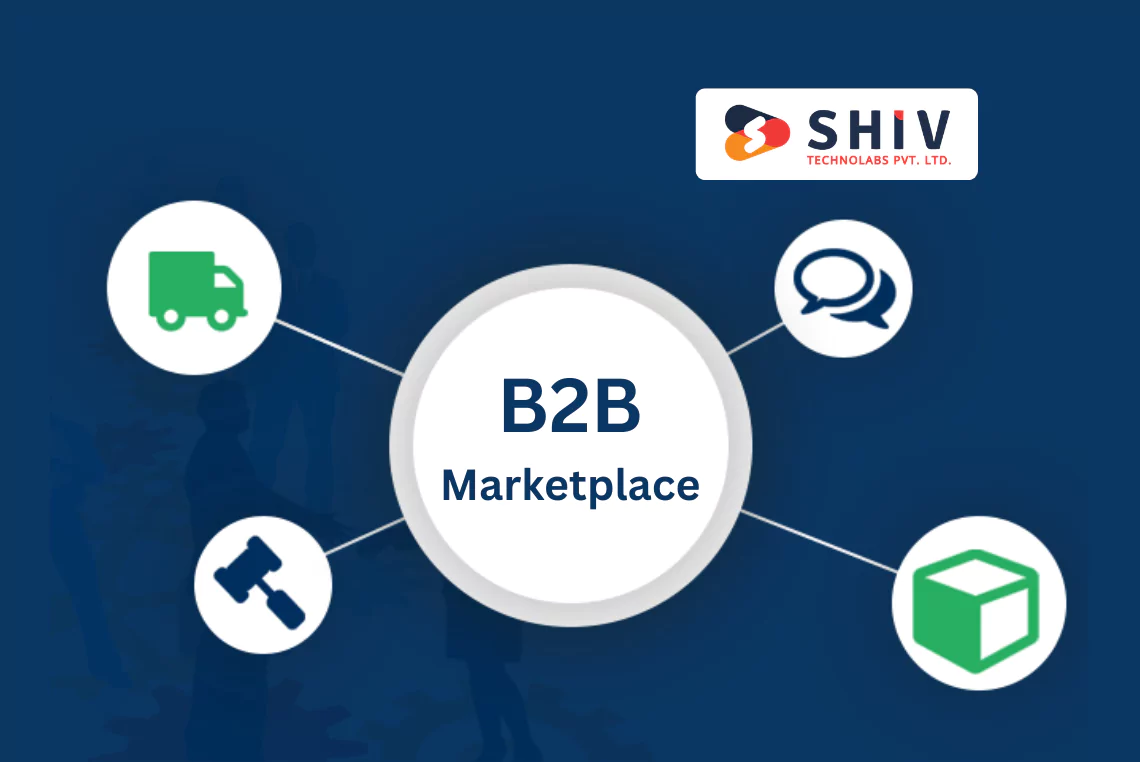Table of Contents
Building a B2B marketplace is no longer just an option; it’s a necessity for businesses that want to stay competitive.
Companies today prefer digital-first platforms where they can connect, negotiate, and complete transactions with ease.
A well-planned B2B marketplace helps buyers and sellers work together more effectively while giving businesses a strong foundation for growth.
In this blog, we’ll cover the key steps, must-have features, and cost factors of B2B marketplace development.
What Is a B2B Marketplace?
A B2B marketplace is an online platform where businesses sell products or services to other businesses. Unlike B2C stores, these platforms focus on bulk orders, negotiations, contract pricing, and long-term supplier relationships.
Well-known examples include:
- Alibaba – Global wholesale supplier network
- ThomasNet – Industrial product directory
- IndiaMART – Supplier-focused platform in India
The core idea is simple: instead of managing multiple one-to-one deals, businesses use a single platform to reach buyers and sellers at scale.
Why Should Businesses Invest in B2B Marketplace Development?
B2B eCommerce is growing rapidly.
According to Forrester, B2B eCommerce transactions are expected to cross $3 trillion by 2027. That means buyers are shifting online faster than ever.
Here’s why companies are choosing marketplace models:
- Efficiency – One digital hub reduces the need for phone calls and emails.
- Transparency – Pricing, availability, and supplier ratings build trust.
- Scalability – Sellers can reach new clients without heavy sales costs.
- Automation – Integrated payments, invoicing, and shipping save time.
Key Steps in B2B Marketplace Development
Building a marketplace requires careful planning. Here’s a breakdown of the main steps:
Step 1: Decide the B2B Model
The foundation of your marketplace lies in the model you choose. It sets the tone for features, workflows, and revenue streams.
- Manufacturer-to-Retailer – Direct bulk sales without middlemen.
- Distributor-to-Wholesaler – Larger supply chains with complex pricing.
- Sector-Specific Platforms – Example: construction materials, healthcare equipment, or electronics.
- Hybrid Models – A mix of suppliers, distributors, and resellers.
Choosing early helps you avoid costly rebuilds later.
Step 2: Plan Bulk Pricing, Contracts, and RFQ Workflows
B2B buyers rarely pay a single flat price. They expect flexibility and negotiation.
- Tiered Pricing – Discounts for higher order volumes.
- RFQ (Request for Quotation) – Buyers invite multiple sellers to quote.
- Contract Pricing – Long-term supply agreements with custom terms.
- Negotiation Tools – Built-in chat or messaging for deal discussions.
These workflows keep your platform aligned with real business practices.
Step 3: Design Company Accounts with Roles and Permissions
Business buyers are usually teams, not individuals. That means one account must serve many roles.
- Procurement Managers – Search and request orders.
- Finance Officers – Approve spending and handle invoices.
- Purchasing Assistants – Place day-to-day orders.
- Admins – Control roles, budgets, and overall account access.
Role-based permissions bring structure to transactions and increase supplier trust.
Step 4: Integrate ERP, CRM, and Accounting Systems
Integration becomes easier if your marketplace is built on strong digital commerce solutions that support ERP and CRM workflows.
- ERP Integration – Sync inventory and order data with tools like SAP or Oracle.
- CRM Integration – Manage customer records through Salesforce or Zoho.
- Accounting Integration – Auto-generate invoices in QuickBooks or Xero.
- API Flexibility – Allow custom connectors for niche business systems.
This step makes your marketplace part of the client’s daily workflow.
Step 5: Build Supplier Onboarding and Catalog Management Tools
Suppliers need the right tools to join and manage products easily.
- Bulk Uploads – Import hundreds of SKUs at once.
- Inventory Management – Track stock levels in real time.
- Dynamic Pricing – Set bulk discounts or seasonal rates.
- Performance Dashboard – Monitor sales, orders, and payments.
A smooth onboarding process helps you attract and retain quality sellers.
Step 6: Add Freight, Multi-Warehouse, and Payment Terms Support
Shipping and payments in B2B are more complex than standard online stores.
- Freight APIs – Integrate with carriers for pallet and container shipping.
- Multi-Warehouse Logic – Split orders across different supplier locations.
- Payment Flexibility – Net-30, credit lines, or escrow options.
- Partial Deliveries – Allow split shipments for large orders.
These features mirror how B2B supply chains work in reality.
Step 7: Test Scenarios Like Multi-Vendor Orders and Bulk Returns
Testing in B2B goes far beyond checking checkout or cart totals.
- Multi-Vendor Orders – One order split across multiple sellers.
- Bulk Returns – Handle cases where only part of a shipment is defective.
- Approval Workflows – Validate orders passing through multiple buyer roles.
- High-Volume Stress Tests – Check system performance for thousands of SKUs and concurrent users.
Covering these cases ensures your platform stands strong under complex demands.
Step 8: Launch with a Strong Seller Acquisition Strategy
Buyers will only join if sellers are active on the platform. That’s why seller acquisition is critical.
- Early Incentives – Discounts on subscriptions or reduced commissions.
- Simple Onboarding – Faster catalog upload and support.
- Marketing Campaigns – Targeted outreach in trade networks.
- Partnerships – Collaborate with industry associations or distributors.
A marketplace with active suppliers will naturally attract buyers.
Must-Have Features in a B2B Marketplace
A strong marketplace balances buyer convenience with seller control. Below is a structured feature list:
1. Buyer Features
- Advanced Search & Filters – Category, price range, supplier rating.
- Bulk Ordering – Support for large quantities with tiered pricing.
- Quote Requests – Buyers request proposals from multiple sellers.
- Order Tracking – Real-time shipment updates.
2. Seller Features
- Dashboard – Sales reports, inventory status, order history.
- Catalog Management – Add, edit, and manage product listings.
- Custom Pricing – Offer bulk discounts or contract pricing.
- Messaging Tools – Direct communication with buyers.
3. Admin Features
- User Management – Control access for buyers and sellers.
- Commission Control – Adjust platform revenue rules.
- Analytics – Insights on sales, top suppliers, and customer activity.
- Payment & Refund Management – Secure transactions with multiple gateways.
Advanced Features for Competitive Edge
To stand out, consider adding:
- AI-driven product recommendations
- Chatbots for customer queries
- Multi-currency and multi-language support
- Integration with logistics partners
- Smart contract support for B2B agreements
Cost of B2B Marketplace Development
The cost of developing a B2B marketplace depends heavily on scope, features, and integrations. Let’s look at a few scenarios to understand how budgets can vary.
1. Cost Based on Development Scale
The size and complexity of your marketplace play the biggest role in cost. Here’s a breakdown by scale:
| Development Scale | Features Included | Timeframe | Estimated Cost Range |
|---|---|---|---|
| MVP (Basic Version) | Product listings, search, payments, buyer/seller accounts | 3–4 months | $25,000 – $40,000 |
| Mid-Level Platform | Dashboards, bulk pricing, RFQs, analytics, integrations | 5–7 months | $50,000 – $90,000 |
| Enterprise Platform | AI, multi-currency, advanced ERP/CRM links, freight logic | 8–12 months | $100,000+ |
An MVP is a good start for testing the idea, while enterprise-grade solutions serve global businesses with complex requirements.
2. Cost Based on Platform Type
Costs also change depending on whether you build a web-only marketplace or include mobile apps.
| Platform Type | Key Features | Development Time | Estimated Cost Range |
|---|---|---|---|
| Web-Only Platform | Full marketplace with responsive design | 3–6 months | $20,000 – $50,000 |
| Mobile App + Web | iOS + Android apps plus admin dashboard | 6–9 months | $60,000 – $100,000 |
| Mobile-First Platform | Advanced app-first model, offline support, push notifications | 8–12 months | $90,000+ |
A mobile-first approach is costlier, but it’s often the right move if your target users operate primarily on smartphones.
3. Cost Based on Feature Set
The more specialized features you add, the higher the development investment.
| Feature Category | Example Features | Extra Cost Estimate |
|---|---|---|
| Core Features | Listings, search, payments, onboarding | Included in base cost |
| Advanced B2B Features | Bulk pricing, RFQs, and role permissions | + $10,000 – $25,000 |
| Enterprise Features | AI product suggestions, multi-language, logistics APIs | + $30,000 – $50,000 |
Adding advanced and enterprise features makes the platform more competitive, but you can roll them out in phases.
4. Cost Based on Region of Development
Where you hire your development team also impacts cost.
| Region | Average Hourly Rate | Estimated Project Cost (MVP) |
|---|---|---|
| North America | $80 – $150/hour | $70,000 – $120,000 |
| Europe (Western) | $60 – $100/hour | $50,000 – $90,000 |
| Eastern Europe | $30 – $60/hour | $25,000 – $50,000 |
| Asia | $20 – $40/hour | $20,000 – $40,000 |
Partnering with offshore teams often reduces cost without compromising on quality, especially for startups testing new models.
As these scenarios show, the final cost depends on scope, features, and team location. A phased approach, starting with an MVP and then adding advanced features, is often the most budget-friendly way to build a scalable B2B marketplace.
Common Challenges in B2B Marketplace Development
- User Adoption – Suppliers may hesitate to onboard. A clear onboarding process helps.
- Scalability – Poor planning may limit growth when users increase.
- Security Risks – Data breaches can harm trust. Strong encryption is vital.
- Payment Delays – B2B payments are often complex; integrations reduce friction.
How Shiv Technolabs Helps Build Scalable B2B Marketplaces?
At Shiv Technolabs, we specialize in custom B2B marketplace development tailored to your business model. Our team covers everything from planning and UI/UX to integrations and security.
We offer:
- Full-cycle development – From idea validation to post-launch support.
- Custom integrations – ERP, CRM, and third-party tools.
- Scalable architecture – Platforms built to grow with your business.
- Industry-specific solutions – From manufacturing to wholesale trade.
Our approach helps you launch faster, lower risks, and deliver a better experience for your buyers and sellers.
Conclusion
Building a B2B marketplace is a smart step for businesses aiming to connect with clients in a digital-first economy. From choosing the right business model to adding advanced features, every step requires strategic planning.
If you’re looking for a trusted B2B marketplace development partner, contact Shiv Technolabs. With expertise in custom solutions and enterprise integrations, we design platforms that drive measurable growth.






















